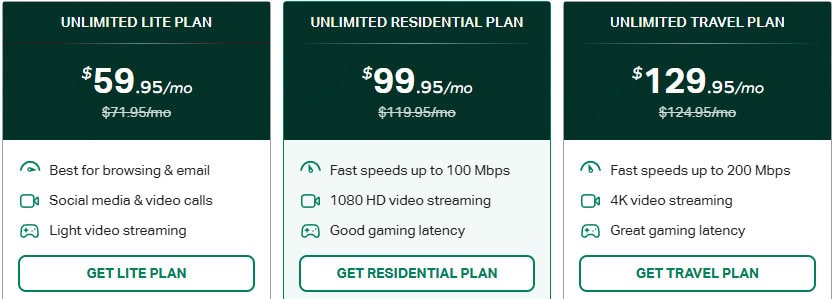If you’re a digital nomad or planning to become one, reliable internet is essential for your livelihood. When your income depends on being connected, you need solutions that work consistently, wherever you are.
One such internet solution for digital nomads based in the USA is through a company called “Nomad Internet”. But is Nomad Internet legit? The short answer: Yes, it’s a legitimate company, but whether it’s right for you depends on your specific needs, location, and budget. Let’s cut through the marketing hype and look at what really matters.
What Exactly is Nomad Internet?
Nomad Internet is a provider that specializes in delivering internet services to people who live or work in remote areas in the USA or who travel frequently in the USA. They offer cellular-based internet solutions that don’t require traditional infrastructure like cables or phone lines.
Their main selling point is providing unlimited data plans through 4G LTE and 5G networks, targeting USA-based RV owners, rural residents, and digital nomads who need internet on the go.
The company offers various plans starting from around $60 per month up to about $130 per month, with different equipment options depending on your needs.

Nomad Internet: The Pros
Let’s start with what Nomad Internet gets right:
- No contracts required – You can pay month-to-month without long-term commitments
- Unlimited data – No hard data caps on most plans (though fair use policies apply)
- Portable solutions – Their routers can be used anywhere within their coverage area
- Multiple carrier options – They work with various cellular networks to provide better coverage
- Customer service – Many users report positive experiences with their support team
Nomad Internet: The Cons
Now for the drawbacks you should know about:
- Price point – Starting at $60/month, it’s more expensive than standard home internet
- Speed limitations – Speeds can vary dramatically based on location and network congestion
- Deprioritization – During peak times, your connection may slow down as carriers prioritize their direct customers
- Equipment costs – Upfront costs for routers range from free to about $120
- Coverage gaps – Not all areas have reliable service, especially very remote locations.
- USA only – For international options, keep reading this article.
How Much is Nomad Internet Really?
Let’s break down the actual costs so you know exactly what you’re getting into:
Monthly service plans range from $60 to $130 depending on the network you choose. This doesn’t include the one-time equipment costs:
- Standard 4G LTE router (Compatible with Standard Power Outlet): FREE
- Mini 4G/5G router (Compatible with External Battery & Standard Power Outlet): $120
- Shipping costs: Typically around $20-30 depending on location
So is Nomad internet worth it? If you’re constantly on the move and need reliable internet in areas without good fixed options, yes. But if you’re primarily staying in areas with decent infrastructure, maybe not.
Real User Experiences: Nomad Internet Review
I’ve spoken with a couple of digital nomads who’ve used Nomad Internet, and their experiences vary widely. Here’s what they shared:
“I’ve been using Nomad Internet for my RV travels across the western US for 8 months. In national parks and remote areas, it’s been a lifesaver for my freelance work. Yes, it’s expensive, but the freedom it gives me is worth it. Speeds range from 5-50 Mbps depending on location.” – James, Web Developer
“It’s a decent backup option, but I wouldn’t rely on it as my primary connection. The unlimited data is great, but the speeds can drop dramatically during peak hours.” – Miguel, Online Tutor
Nomad Internet Alternatives Worth Considering
Before committing to Nomad Internet, consider these alternatives that might better suit your needs and budget:
1. Starlink
Elon Musk’s satellite internet service has been a game-changer for remote workers. At $120/month plus $599 for equipment, it’s comparable to Nomad Internet in price but offers more consistent speeds (typically 50-200 Mbps) and truly global coverage.
The downside? The dish requires setup and clear sky view, making it less convenient for frequent movers. However, they now offer a more portable “Roam” option specifically for RVs and mobile users.
2. Mobile Carrier Hotspot Plans
Major carriers like Verizon, AT&T, and T-Mobile offer dedicated hotspot plans or high-data phone plans with hotspot capabilities:
- Verizon’s 150GB plan costs around $80/month
- AT&T offers 100GB for approximately $55/month
- T-Mobile has unlimited plans with 40-100GB of hotspot data starting at $60/month
These are significantly cheaper than Nomad Internet, though they do have stricter data caps.
3. Local SIM Cards
If you’re traveling internationally, purchasing local SIM cards often provides the best value. In many countries, you can get unlimited data plans for $20-40 per month. This requires an unlocked phone or dedicated hotspot device.
4. eSIM Services
Services like Airalo, Holafly, and Nomad eSIM (not related to Nomad Internet) offer digital SIM cards you can download to compatible devices. These are incredibly convenient for international travelers as you can switch providers without changing physical SIM cards.
Pricing varies widely based on data needs and countries, but typically ranges from $5-20 for 1-10GB of data, making them more suitable for short-term use or as backups.
Recommended Digital Nomad Internet Setup
Here’s the setup I recommend for maintaining connectivity while working remotely:
Primary Connection: Dual SIM Phone
Use a phone that accepts two physical SIMs plus eSIMs. This allows you to:
- Keep your home country number active on one SIM
- Use a local SIM from whatever country you’re in.
- Have an eSIM as backup from providers like Airalo
Then use your phone as a hotspot for your laptop when needed. This setup would cost approximately $60-80 per month total.
Backup: Portable Hotspot Device
For times when you need to connect multiple devices or preserve your phone battery, I recommend you carry a Gl.iNet Beryl (GL-MT1300) travel router ($70 one-time cost). This compact device can:
- Create a WiFi network from a wired connection
- Accept a SIM card to create a 4G hotspot
- Connect to existing WiFi and rebroadcast it (useful for hotel WiFi)
Emergency Backup: Starlink or Nomad Internet
For extended stays in remote locations, I recommend one of two choices:
- Starlink’s portable option. (For international travel) At $599 for equipment plus $120/month, it’s expensive but unbeatable for truly remote work.
- Nomad Internet (For travel in the USA)- Get one of their unlimited data plans through 4G LTE and 5G networks. The equipment (4G/5G routers) is more compact and simpler to install than Starlink.
Common Digital Nomad Internet Issues and Solutions
No matter which provider you choose, you’ll likely encounter these common challenges. Here’s how to address them:
Problem: Unreliable Connections During Video Calls
Solution: Always have a backup connection ready. Before important calls, test your primary connection and have your phone hotspot ready to switch to if needed. Also, consider using tools like Krisp.ai to reduce the bandwidth needed for clear audio.
Problem: Public WiFi Security Risks
Solution: Always use a VPN to protect your data from potential hackers on shared networks. I recommend ExpressVPN or NordVPN.
Problem: Data Usage Exceeding Limits
Solution: Use data-saving browsers like Opera Mini and enable data-saving modes in apps. Download content for offline use when on WiFi. For video meetings, turn off your camera when not needed to significantly reduce data usage.
Problem: Finding Reliable WiFi While Traveling
Solution: Apps like WiFi Map and WorkFrom help locate reliable WiFi spots. Alternatively, consider co-working spaces which typically offer high-speed, reliable connections for daily or monthly fees ($10-30 per day or $100-300 per month depending on location).
How to Choose the Right Internet Solution for Your Digital Nomad Lifestyle
The best internet solution depends on your specific work requirements and travel patterns. Here’s a quick decision framework:
For Frequent International Travelers:
- Primary: Local SIMs + eSIM backups
- Secondary: Portable hotspot device.
- Budget: $50-100/month
For RV/Van Life in One Country:
- Primary: Unlimited carrier plan or Nomad Internet (USA)
- Secondary: Starlink for very remote areas
- Budget: $80-180/month
For Long-term Stays in Remote Locations:
- Primary: Starlink (international) or Nomad Internet (USA)
- Secondary: Local 4G/5G options
- Budget: $120-150/month
For Digital Nomads in Urban Areas:
- Primary: Local SIMs or WiFi at accommodations/co-working spaces
- Secondary: Phone hotspot with decent data plan
- Budget: $30-60/month
Final Verdict: Is Nomad Internet Worth It?
Nomad Internet is a legitimate service that delivers on its core promise: providing internet connectivity in areas of the USA where traditional options aren’t available.
It makes the most sense for:
- Full-time RVers traveling within the USA
- Remote workers in rural areas in the USA with poor infrastructure
- People who need truly unlimited data and are willing to pay for it
For most digital nomads, especially those traveling internationally or staying primarily in urban areas, the combination of local SIMs, eSIMs, and occasional use of co-working spaces will provide better value and potentially more reliable connections.
The bottom line: Nomad Internet is legit specialized service that makes sense for specific use cases in the USA.
Whatever solution you choose, always have a backup plan. Your income depends on staying connected, so redundancy isn’t just nice to have – it’s essential for the digital nomad lifestyle.
Frequently Asked Questions
Is Nomad Internet truly unlimited data?
Nomad Internet does offer unlimited data plans without hard caps, but they are subject to fair use policies. This means if you use excessive amounts of data (typically hundreds of GB per month), you may experience reduced speeds during network congestion. Their terms of service also prohibit certain high-bandwidth activities like continuous video streaming or hosting servers.
How fast is Nomad Internet in real-world conditions?
Real-world speeds with Nomad Internet typically range from 5-50 Mbps for downloads and 1-10 Mbps for uploads, depending on your location, the time of day, and network congestion. Urban areas generally see better performance than rural locations. These speeds are sufficient for most remote work tasks including video calls, but may not support 4K streaming or large file uploads consistently.
Can I use Nomad Internet internationally?
No, Nomad Internet is designed for use within the United States only. Their service relies on U.S. cellular networks and does not offer international roaming capabilities. If you’re traveling internationally, better options include local SIM cards, international eSIMs, or global satellite services like Starlink.
What happens if there’s no cellular coverage where I’m staying?
If you’re in an area with no cellular coverage from any of Nomad Internet’s partner networks, the service simply won’t work. Before purchasing, check their coverage maps carefully and consider having a backup option like Starlink for truly remote areas. Some users report success with external antennas to improve reception in marginal coverage areas.
Is there a contract or cancellation fee with Nomad Internet?
Nomad Internet offers month-to-month service without long-term contracts or cancellation fees. You can cancel at any time without penalty, though they do not offer prorated refunds if you cancel mid-billing cycle. Equipment purchases are non-refundable after the initial 14-day return period.
How does Nomad Internet compare to using my phone as a hotspot?
Compared to using your phone as a hotspot, Nomad Internet offers higher data limits (unlimited vs. typically 5-100GB on phone plans), better battery life since it’s a dedicated device, and the ability to connect more devices simultaneously. However, phone hotspots are more portable, don’t require additional equipment purchases, and are generally much less expensive if you don’t need massive amounts of data.
